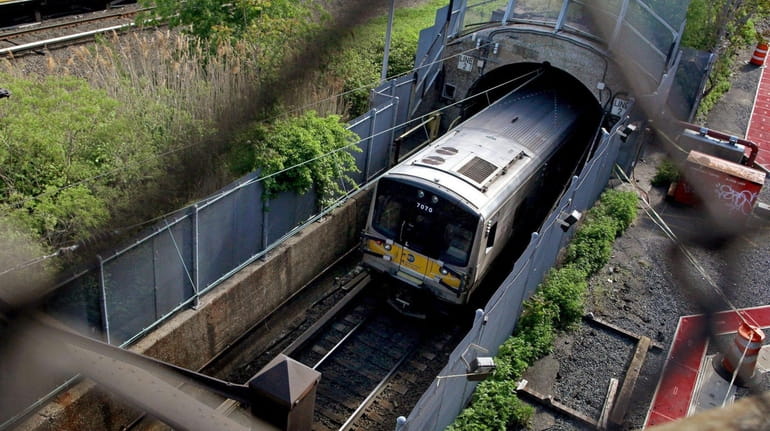New hope for tunnel vision

An LIRR train disappears into the East River Tunnel, travelling westbound on the way to Penn Station, under the 49th Ave. underpass. Credit: Craig Ruttle
Even with ongoing expansion, upgrades, and attempts to encourage people to take the train, the Long Island Rail Road won't be able to go anywhere without one key link: the East River Tunnel.
The four tubes under the East River, which are owned by Amtrak but carry every LIRR train to and from Penn Station, are old. Two were severely damaged by superstorm Sandy and are in desperate need of repair.
Now, they finally may get the attention they deserve.
After years of haggling and finger-pointing between Amtrak and the Metropolitan Transportation Authority, the two transit giants have reached a moment of apparent collaboration. That's thanks in part to Senate Majority Leader Chuck Schumer, who helped broker a deal to fund the work. The MTA will pay $432 million for the tunnel's rehabilitation, while Amtrak coughs up $500 million toward the Penn Station Access effort to bring Metro-North Railroad to Penn Station.
The unusual agreement between Schumer, Amtrak chief executive Tony Coscia, and MTA chief executive Janno Lieber hopefully is just the beginning. If it becomes a true working partnership, it's possible the critical tunnel work might be completed more quickly than anticipated.
But that depends on Amtrak.
Previously, the federal transportation operator had not shown any urgency. The design phase has taken years and still isn't finished. Meanwhile, Amtrak's board of directors contains vacancies and members whose terms have expired. President Joe Biden, a longtime champion of Amtrak, would be wise to quickly appoint new members, including those with New York connections.
Despite those concerns, Amtrak now seems ready to speed up its effort. In a statement, Amtrak told the editorial board it was reviewing its contracting plans "to accelerate completion of this long-overdue project …" Its timetable is still lengthy, with major construction expected to stretch until 2027. While work can't start until the LIRR's East Side Access connection to Grand Central Terminal is complete at the end of 2022, Amtrak should speed things up by prioritizing the project, assigning enough workers to it, and innovating.
Once work starts, Amtrak and the MTA must keep riders informed about schedule changes and outages; Amtrak plans to close one East River tube at a time which will cause disruptions.
Meanwhile, as Penn Access moves forward to benefit Metro-North, the MTA must make sure there aren't negative consequences for the LIRR that would stymie its expansion. The two commuter rails must complement each other, without hurting one another's growth.
Also important: Amtrak and the MTA must ensure Gov. Kathy Hochul's proposals to remake Penn Station and its surroundings come to fruition.
Coordinating these projects to minimize disruption is easier said than done. But the MTA-Amtrak agreement could portend a successful effort over the next five or six years to bring a commuting renaissance for Long Island residents.
MEMBERS OF THE EDITORIAL BOARD are experienced journalists who offer reasoned opinions, based on facts, to encourage informed debate about the issues facing our community.
